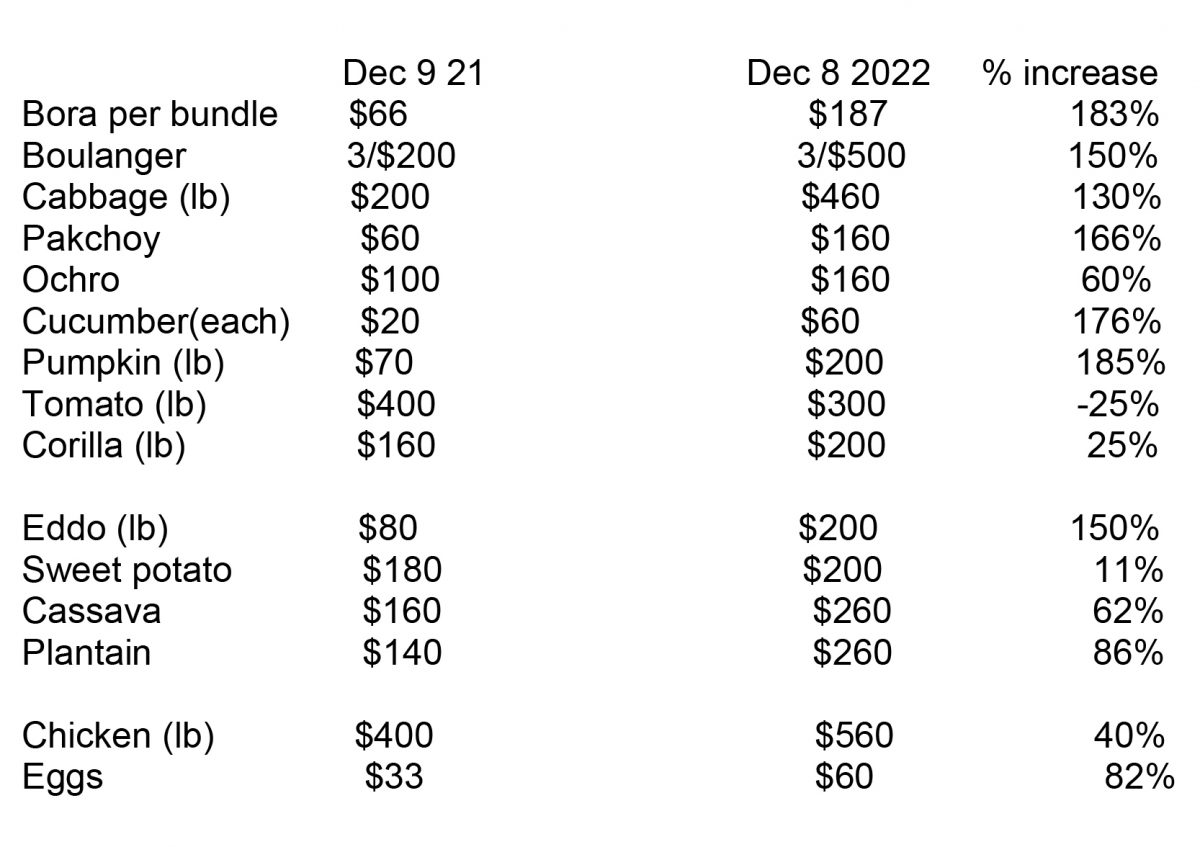It is not clear how genuinely concerned the administration is towards the plight of poor people and the daily stress they are under over the current cost of living crisis.
After all VP Jagdeo said the other day if you’re not working right now you’re “damn lazy”. It would appear the party that sang the Internationale is now the party of Social Darwinism.
Aside from this newspaper’s feature series interviewing people about the cost of living, it might be useful to look at the weekly NGMC statistical “Average Wholesale and Retail Prices at Rural and Urban Markets”.
For this we can examine the difference in prices between the week of December 9 2021 and December 8 2022 as recorded in Stabroek Market.
Some other items such as beef and pork did not increase and fruits were relatively stable. But let us pause here and discuss what has happened to these items that must be considered nutritional staples for the average Guyanese household. Only one item decreased – tomatoes. Every other item increased from a minimum of 22% (corilla) to a maximum of 185% for pumpkin. Cucumbers increased three-fold. The average increase of these listed items was 70%. In other words if you were to go into the market with $10,000 to spend in 2021, you would need $17,000 one year later.
It is also worth noting the disparity between the wholesale price at the Parika farmgate for some items and the average retail price for them at Stabroek Market.
For example pumpkin in 2021 was selling for $50 per lb and was $55 in 2022 but the retail price went from $70 to $200. This is suggestive of many anecdotal reports of price gouging by middlemen. It is one reason why the Ministry of Agriculture has been promoting the farmer’s markets although they clearly have not had an impact on lowering prices elsewhere.
As for items not on the list, think how flour, milk, powder, bread – in fact everything – have also gone up in the past year.
Why is this happening? It is not clear. Certainly weather must be playing a factor along with increased demand from the oil sector and its onshore and offshore employees. However that cannot explain it all and really this is part of the wage/inflation spiral that is infecting the economy. It is not only a result of higher prices for inputs but driven by the heightened expectations of oil wealth that started in May 2015. This has only accelerated in part because all the politicians ever talk about is the coming prosperity for all. Increases are not limited to commodities but also services. One electrician when asked to name his price for a simple repair, said there was a “consultation fee” on top of the cost for the repair. The economy is overheating and the President has already said he is turning up the heat even more!
How long might this peculiar situation continue with the burden falling on the working poor? And what might be the remedies? A lowering of duties on imports of vegetables and provisions? One saw how effectively shipments of tomatoes from Brazil in August 2022 tamed the market price for local ones thereby suggesting that this is not a simple matter of supply and demand but maybe more about rank profiteering. In the case of chicken which is the principal source of protein, allowing the legitimate importation of foreign chicken would help make it far more affordable.
And these are piecemeal – not holistic approaches. One option would be to encourage an appreciation of the Guyana dollar thereby lowering import prices. Some have said this would hurt exporters but since many inputs are imported it might be workable if done gradually. Guyanese need more money in their pockets. It’s as simple as that. On the eve of Monday’s budget, it is imperative we see relief for all. This can be done by rebates on electricity, water, even taxes for those who choose to pay them. The messaging from the government to date is not encouraging.
Meanwhile come Monday please remember these Big Market prices when Minister Singh stands up to reel off a series of fabulous (fabulistic?) statistics pointing to another great year of progress.

